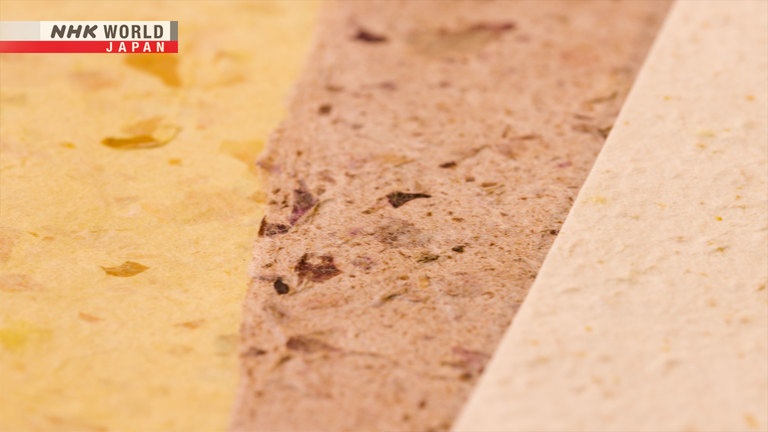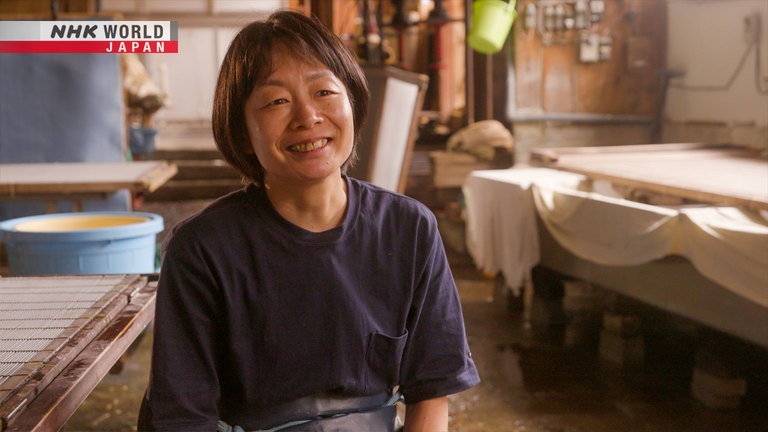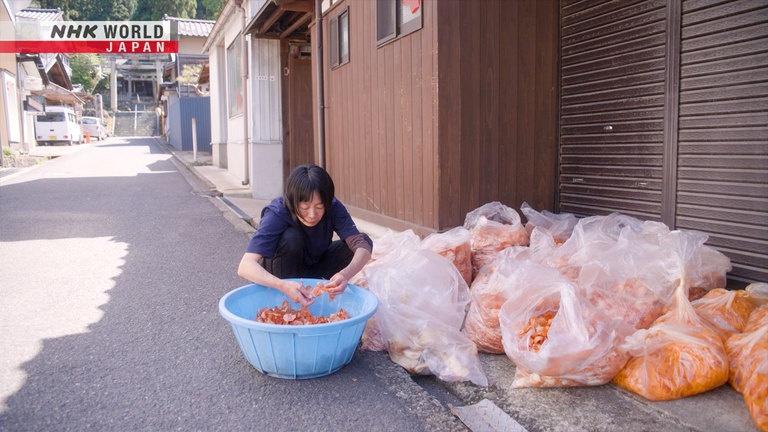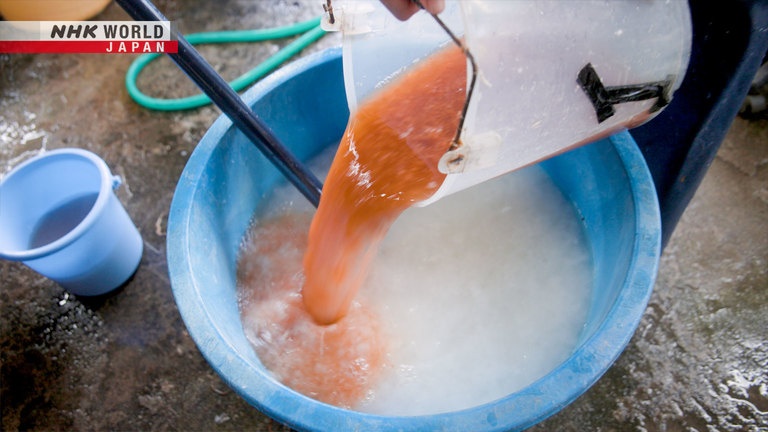Food Waste Washi
Echizen City in Fukui Prefecture is a major center for washi paper production. There, papermaker Igarashi Masami created "Food Paper," combining produce like potatoes or onions – mainly discards and scraps from the food industry – with paper mulberry, the traditional material for washi. Her aim is to raise awareness of food loss using traditional crafts. The paper also reflects the natural color of the ingredients; another part of its appeal. It's a new page in the 1,500-year history of Echizen washi.




Transcript
Since ancient times, the Japanese have believed that a life force resides in all creations.
Valuing and caring for the things we use, a "Zero Waste Life."
Pointing the way to better living for a new era.
Throwing food away again? What a waste!
We have to be aware of the problem,
and do something to change it.
Echizen is one of the three major production centers for traditional "washi" paper.
With a history of around 1,500 years, the papermaking industry has been inherited by each succeeding generation.
Here, in the home of "washi" paper, the aroma of fruit emanates from one of the workshops.
In this over 100-year-old business, Igarashi Masami - 4th-generation papermaker - is hard at work.
The source of the fruity aroma...
mandarin orange peels she's using to make paper.
I get the peels from school lunches
and discards from the supermarket.
Igarashi also collects vegetable scraps and unsellable substandard produce for her paper.
I guess there's something wrong with it,
but it looks perfectly edible to me.
It's a pity to let it go to waste.
New Echizen "washi" paper born from discarded produce; she's dubbed "Food Paper."
Today, she's visiting a food processing plant to collect their discards.
Hello. Thank you for all your help.
This plant produces cut vegetables.
They throw out scraps like leaves and peels every day;
from 500 kilograms to as much as a ton of them.
Such discards have long been an issue.
Thank you so much!
To ensure quality products for our customers,
we inevitably end up throwing things out.
We've struggled to find some way
to make use of them.
Once she returns to the workshop, the first step is processing the discarded vegetables.
I can't use this much all at once,
so I air dry it to prevent mold.
One at a time, she carefully lays out the onion skins to dry in the sun.
This also helps to improve the color.
She next washes the potato peels by hand.
Washing makes them a bit firmer.
And then I dry them.
It wouldn't be right if I didn't use
everything they gave me.
Okay, all set.
With the processing done, it's now time to start making the "food paper."
She'll be using the onion skins she dried earlier.
After weighing, they're placed in an industrial blender.
Just right!
Next is paper mulberry (or "kozo"), "washi's" traditional base ingredient.
The pulp is dissolved in water to loosen the fibers.
The processed onion skins are then mixed in and finally,
mucilage made from the roots of a type of hibiscus is added.
Evenly blending the onion and mulberry fibers makes the paper stronger.
The mixture is poured over a screen frame, a traditional papermaking technique.
It's early spring,
so there's a fresh onion feel.
It's got a gentle muted color tone
that's very cute, I think.
Once the sheet is formed, it's left out in the sun to dry for a full day.
The uneven texture and natural colors of the food ingredients give a seasonal flavor to the finished product.
Depending on the time of harvest and the type of produce,
and even the area in which it was grown the colors vary, so no two sheets are alike.
Food Paper got its start three years earlier with a hint from Igarashi's son Yuto's summer term school project.
When I was nine,
I saw banana paper being made on TV.
Since we're papermakers I thought
it would make a good summer project.
This is the banana paper that started it all.
Yuto was fascinated by the notion that you could make paper from food.
And he experimented with making "washi" from ingredients they had at home.
When I came home from work
and started to make dinner,
celery, cabbage, lettuce...
all the veggies in the fridge were gone.
The idea to use Yuto's vegetable-based "washi" as a way to combat the problem of food waste came from Igarashi herself.
But she was conflicted about making changes to traditional Echizen "washi."
We've made "washi" for nearly 1,500 years,
paper once used for printing money,
paper that's become emblematic of Japan.
I was worried it would be disrespectful
to the papermakers who came before me.
They might say, don't mix scrap into
our paper, that's not Echizen "washi"!
It's fine if people are angry at me,
but I don't want to bring shame on others.
I anguished over what I should do.
It was her father, the one who taught her papermaking, who urged her to try.
I was a bit skeptical about
using produce in Echizen "washi."
But demand for traditional products
has been declining year by year.
So, I thought why not try Yuto's idea.
It's important to preserve the tradition,
but new ideas are important too.
A new form of Echizen "washi:" born from a son's original idea and a mother's traditional techniques.
When mom said she turned my project
into a product, I didn't understand at first.
He thought I was joking.
I'm happy I could help, but I think
it's even more important
to use this opportunity to share my love
of traditional "washi" paper.
Including notebooks and greeting cards, they've created a number of Food Paper products.
Today is the day of the annual spring festival held each May.
It gives thanks to the goddess who, legend has it, brought papermaking to this land,
a ceremony passed down for over 1,300 years.
A paper market is also held in conjunction with the festival,
and people come from all over Japan to buy Echizen "washi."
Many are curious about Igarashi's Food Paper.
- Potato. The color is nice.
- It's a muted tone.
- This green one?
- It's green onion.
Green onion? Interesting!
"Washi" made from potatoes is new.
It has a warm natural feel.
It's great, and an important issue.
Does it smell?
Onions, green onions, all onions!
I'm in a craft circle with my kids
and I thought we could use it,
so I bought some.
How much of it is vegetables?
For carrot, it's about 40%.
Really?! That much?! Amazing!
Thank you so much.
I never knew food waste
was such a global issue.
I might not be able to fix it,
but I want to spread the word
so more and more people know
and we can find a solution.
If one person becomes two, then five...
even if we don't reach everyone,
we can do big things.
Even though it caused me anguish,
I'm glad I saw the idea through.
I'd love to see Echizen "washi" and
food waste reduction spread together,
and make a happier world for everyone.